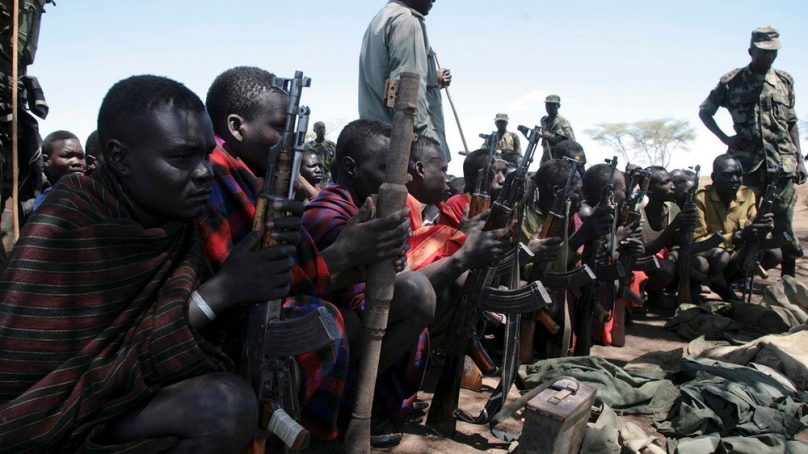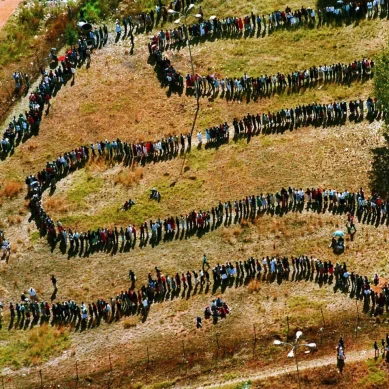
The stench of livestock lingered in the empty enclosure made of thorny branches where Aomet Lokong stood, a kraal head without any cows. Armed rustlers raided Lokong’s communal kraal, or cattle enclosure, in northeastern Uganda’s Kaabong district in late November and stole nearly 1,000 cows, local officials said.
Six days later, the animals were still missing. “When the raiders come here, they find only children protecting the cows,” said Lokong, despondent beneath his orange hat. “There is no one to scare them away because people have disarmed.”
The nine districts of Karamoja, as this semi-arid northeastern borderland is known, enjoyed a decade of peace after the army disarmed gun-wielding rustlers in the early 2000s. But in the last two years the raiders have returned, killing hundreds of people and stealing the cattle that are their livelihoods.
A fresh disarmament campaign, launched by the army in July 2021, has so far failed to stem the violence, while drawing allegations of human rights abuses.
Outside the kraal, gaunt men with tartan blankets had gathered to meet with local politicians. Their frustration was palpable: Of 34 kraals in the district, just four had been spared from the raids.
Lokong spoke with an orator’s flourish, flinging out his arms and stooping to his knees. The army was doing nothing to protect their cows, he said. He had heard talk that soldiers were profiting from the raids. Soon, he worried, people would re-arm themselves.
Then, younger herders stepped forward. “The cow is our bank,” said one. Without it, he asked, how can we send our children to school? Another gestured at the politicians: They just sat in their offices and did nothing, he complained.
Karamoja is a hot, dry savannah and, at 30,000 square kilometres, the size of a small country. People here are sometimes referred to as the Ngikaramojong or Karamajong, a loose term encompassing several distinct groups.
Many of them herd livestock, though they often grow crops too. The region is far from the capital, Kampala, and nowhere in the country is as poor. Literacy rates are just 25 per cent.
People in Karamoja want peace, it was repeatedly said. But until the government protects their cows and creates economic opportunities, some young men will see little alternative to fighting.
A letter drafted in November by community leaders in east Kaabong claimed that nearly 2,000 cattle had been stolen there since June.
“There have been decades of mistrust between the state and the Ngikaramojong,” said Simon Peter Longoli, executive director of the Karamoja Development Forum, a civil society organisation.
“The government doesn’t value Ugandan lives equally,” he says. “Some people are more important than others. And at the bottom of the hierarchy, that’s where you’ll find the Ngikaramojong.”
The Ugandan state has been trying to disarm the people of Karamoja for the best part of a century. In 1979, after the collapse of Idi Amin’s regime, soldiers abandoned the barracks in Moroto, leaving its unguarded cache of weapons to spill across the region. Violence reached unprecedented levels.
Under the current president, Yoweri Museveni, the army launched disarmament campaigns in 2001 and 2006. Thousands of guns were recovered, and by 2010 relative peace was restored. But the army’s tactics were brutal, and little was done to rehabilitate the young men who gave up their guns.
In the words of Jino Meri, the elected chairman of Kaabong district, “they didn’t have post-disarmament programmes to disarm the mind”.
Now, trouble has returned. The first warning sign was a spate of thefts by petty criminals – known as ‘lonetia’ – that began more than a decade ago. Initially, cows started being taken, just one or two at a time, but soon the local rivalries escalated into tit-for-tat raids.
One hotspot was the fertile pasture around Kobebe dam, where Turkana cattle herders from neighbouring Kenya would come to graze their cows. They had never been disarmed, and soon there was a flow of guns across the porous border, as some Turkana joined forces with resurgent local raiders.
By the end of 2019 the situation had “spiralled out of hand”, according to a report presented to the president last year by the Karamoja Parliamentary Group of lawmakers. “The lack of intervention by the security [forces] to recover lost property created apathy,” they wrote, and resulted in “communities taking the law into their own hands”.
The problem was made worse by a foot-and-mouth disease outbreak in some areas, and then by Covid-19, both of which disrupted the legitimate cattle trade and left young men idle.
The level of violence remains lower than it was in previous waves of raiding, and there are far fewer guns than in the past. Nonetheless, the state’s monopoly on violence is being eroded. Rival groups within Karamoja – linguistically and culturally related, but with distinct local identities – are turning against each other.
“They didn’t have post-disarmament programmes to disarm the mind.”
- The New Humanitarian report











